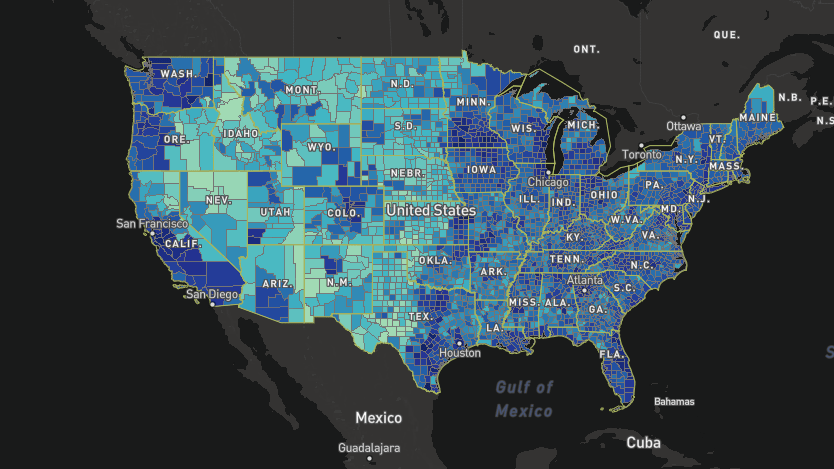To get broadband to every American, you need to know the rules in all 50 states

The digital economy (as we like to call it over here) depends heavily on access to the internet, and that is still not a solved problem here in the United States. Over 30% of Americans don’t have access to broadband internet — defined as 25 megabits per second or higher — according to research released Tuesday by The NPD Group.
The Pew Charitable Trusts wants to figure out why. The organization’s Broadband Research Initiative is launching a new tool Wednesday that lets anyone browse through broadband policies and funding in any state in the U.S. It sorts the information into categories like funding, competition and regulation, infrastructure access and broadband definitions. For example, broadband speed in Alabama is defined as 10 Mbps, which means that if your network is busy, it’ll barely be fast enough to stream Netflix on high definition.
Host Molly Wood spoke with Kathryn de Wit, who manages the Broadband Research Initiative for the Pew Charitable Trusts. She said state policy is a huge deal when it comes to expanding broadband access. The following is an edited transcript of their conversation.
Kathryn de Wit: State policy matters because lack of access to broadband is a national issue, but it is felt at the local level. States have taken an aggressive approach to closing gaps in access, particularly over the last five years. We’ve seen a significant uptick in legislation since 2015. What we can take away from this is not only do state policymakers see and feel that immediate urgency of lack of broadband access, [but] they’re saying it’s important to things like education, health care and economic development. They’re also saying, “This is what we want our state to look like.” They’re setting goals, and then they’re laying out a path and a framework for how to achieve those goals.

(Illustration courtesy of Pew)
Wood: Let’s just dive into what is in the tool — some of the different approaches that states are taking. Could you give me an example of two totally different approaches that states might have taken?
De Wit: Going into this research, we knew that states face similar challenges in increasing access to broadband, but we learned that they’re also taking similar approaches but adapting them to their needs. That’s really where those categories came from, those groupings. If you look at goals, for example, you have states like Minnesota and West Virginia where their statewide broadband goals are focused on border-to-border universal coverage. Then you look at a state like California that has a goal to connect 98% of the population and each one of its roughly 20 regions.
Wood: How do you hope that a tool like this can help close the digital divide in terms of broadband access?
This tool is the first step in our ongoing research on how states are addressing gaps in broadband access.
Kathryn de Wit
De Wit: This tool is the first step in our ongoing research on how states are addressing gaps in broadband access. For us, this was about understanding that 50-state landscape of broadband deployment laws. And it provides the basis for our next level of research, which is a deeper examination of how states are addressing those gaps in access. What we hope, though, is that users will be able to use this tool to learn what other states are doing and how they’re doing it.
Related links: more insight from Molly Wood
This tool is new, and Pew hopes that policymakers and local governments will jump in and start creating some analysis and comparison and will be publishing their own pieces. The first one that I mentioned is about how states fund their broadband projects, whether it’s grants or loans or general funds or creative funding.
Apparently Illinois makes internet service providers pay into a special coffer called the Digital Divide Elimination Infrastructure Fund. It uses that to pay for broadband buildouts. And in Virginia, a legal settlement with tobacco producers is paying to build more internet.
I’m not saying this isn’t a little wonky over here, but it is interesting. Also, I’ve got to be honest, I’m still hung up on that 10 Mbps in Alabama, and probably some other states, too. I haven’t made it through the entire tool yet.
Alabama’s regulation also defines broadband upload speeds as just 1 Mbps. So basically, if you were at home trying to upload some photos to Facebook or anything to the cloud, you’d be doing that at speeds 10 times slower than the slowest 4G cellphone connection. Set it and forget it, because it’s going to take all night.
This speed question is so controversial that even though Pew is using the 25 Mbps speed guideline, which is set by the Federal Communications Commission, network congestion usually means actual speeds are nowhere near that fast. And again, a 4G phone connection is faster than that on the best providers.
It’s such a big discrepancy that while Pew says 21 million Americans don’t have broadband, Microsoft put out its own map of high-speed internet access back in April. It said the real number of people without appropriately fast internet access for today’s economy is more like 163 million in the United States alone.
The future of this podcast starts with you.
Every day, the “Marketplace Tech” team demystifies the digital economy with stories that explore more than just Big Tech. We’re committed to covering topics that matter to you and the world around us, diving deep into how technology intersects with climate change, inequity, and disinformation.
As part of a nonprofit newsroom, we’re counting on listeners like you to keep this public service paywall-free and available to all.
Support “Marketplace Tech” in any amount today and become a partner in our mission.

















